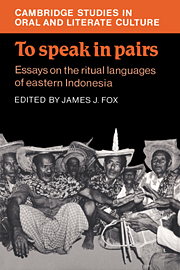Book contents
- Frontmatter
- Contents
- Illustrations
- The contributors
- Acknowledgements
- Introduction
- 1 Etiquette in Kodi spirit communication: the lips told to pronounce, the mouths told to speak
- 2 Method in the metaphor: the ritual language of Wanukaka
- 3 Li'i marapu: speech and ritual among the Wewewa of west Sumba
- 4 The Pattern of Prayer in Weyéwa
- 5 Fashioned speech, full communication: aspects of eastern Sumbanese ritual language
- 6 Manu Kama's road, Tepa Nilu's path: theme, narrative, and formula in Rotinese ritual language
- 7 The case of the purloined statues: the power of words among the Lionese
- 8 The journey of the bridegroom: idioms of marriage among the Endenese
- 9 A quest for the source: the ontogenesis of a creation myth of the Ata Tana Ai
- 10 The Tree of Desire: A Toraja ritual poem
- Notes
- References
- Index
9 - A quest for the source: the ontogenesis of a creation myth of the Ata Tana Ai
Published online by Cambridge University Press: 19 October 2009
- Frontmatter
- Contents
- Illustrations
- The contributors
- Acknowledgements
- Introduction
- 1 Etiquette in Kodi spirit communication: the lips told to pronounce, the mouths told to speak
- 2 Method in the metaphor: the ritual language of Wanukaka
- 3 Li'i marapu: speech and ritual among the Wewewa of west Sumba
- 4 The Pattern of Prayer in Weyéwa
- 5 Fashioned speech, full communication: aspects of eastern Sumbanese ritual language
- 6 Manu Kama's road, Tepa Nilu's path: theme, narrative, and formula in Rotinese ritual language
- 7 The case of the purloined statues: the power of words among the Lionese
- 8 The journey of the bridegroom: idioms of marriage among the Endenese
- 9 A quest for the source: the ontogenesis of a creation myth of the Ata Tana Ai
- 10 The Tree of Desire: A Toraja ritual poem
- Notes
- References
- Index
Summary
In … the liberation of mythic thought and the separation of the person beginning to enter into his own history, there are no watertight partitions … between the notions of person, intelligence, rationality, and myth.
Maurice Leenhardt, Do KamoIntroduction
The Ata Tana Ai (People of the Forest Land) inhabit the watershed and tributary valleys of Napun Geté, the largest riparian system of the Regency of Sikka in eastern Flores. Tana Ai is a region of well-watered forest land insulated from the neighbouring peoples of eastern Flores by high mountain ridges to the east and west. Within their valley the Ata Tana Ai have maintained a society and a ceremonial system that are quite distinct from those of the peoples of central Sikka to the west and Larantuka (Regency of East Flores) to the east.
Despite increasing pressures from both the state and the Catholic church, the Ata Tana Ai maintain their traditional religion and a ceremonial system that integrates clans and maternal houses into larger social and political entities. Tana Ai is divided into several ceremonial domains, called tana in the local language, each of which is led by a tana puan, who is ‘Source of the Domain’ or ‘Source of the Earth’. While they are generally comparable, the rituals and myths of the various tana of Tana Ai comprise distinct traditions. The largest tana of Tana Ai, and the one most important to the Ata Tana Ai themselves, is Tana Wai Brama. It is this central domain whose myths and ritual language are the subjects of this essay.
- Type
- Chapter
- Information
- To Speak in PairsEssays on the Ritual Languages of eastern Indonesia, pp. 246 - 281Publisher: Cambridge University PressPrint publication year: 1988
- 3
- Cited by



